Bamlanivimab vs Placebo (RCT)
Mild outpatients
FOREST PLOTS -2023-01-06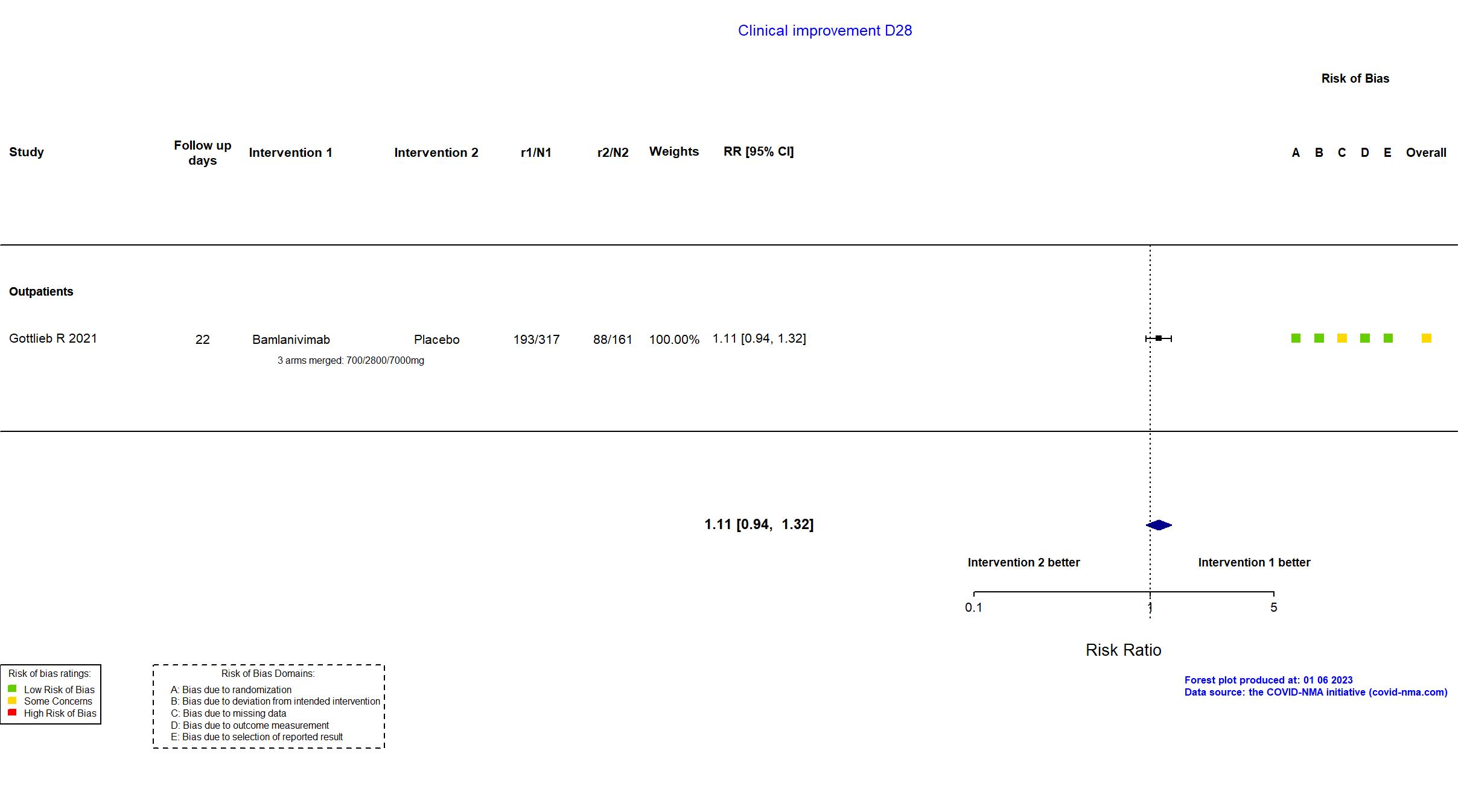
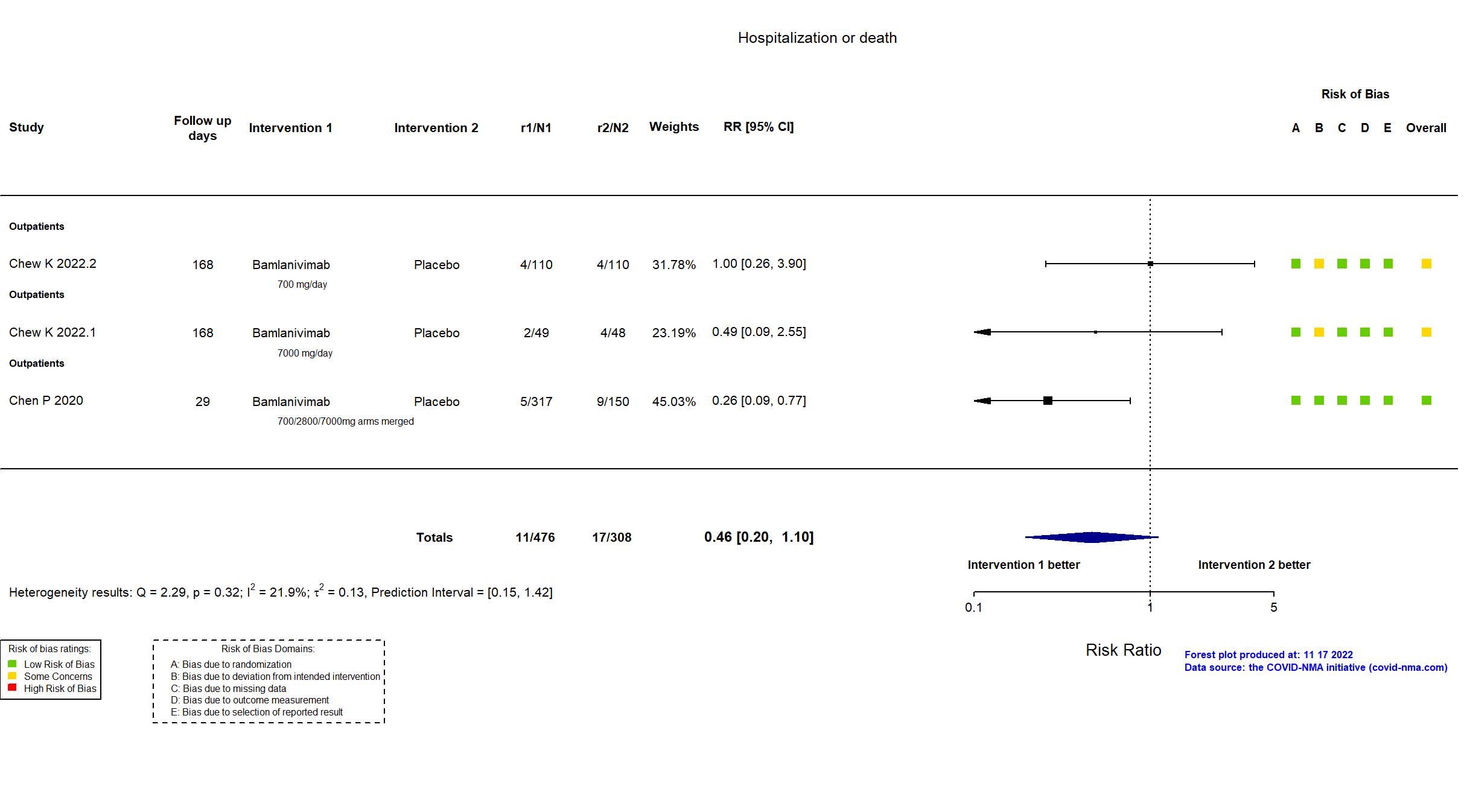
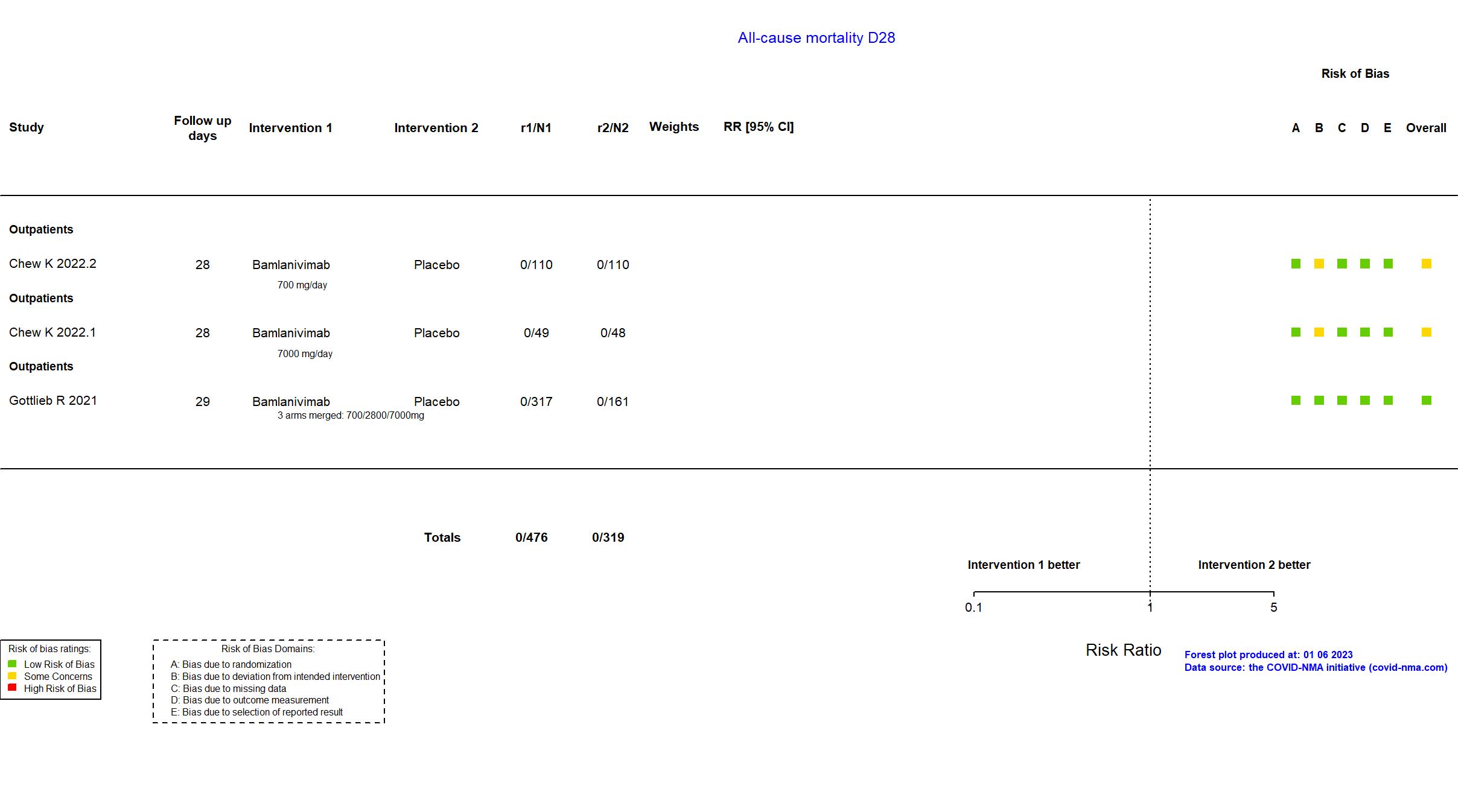
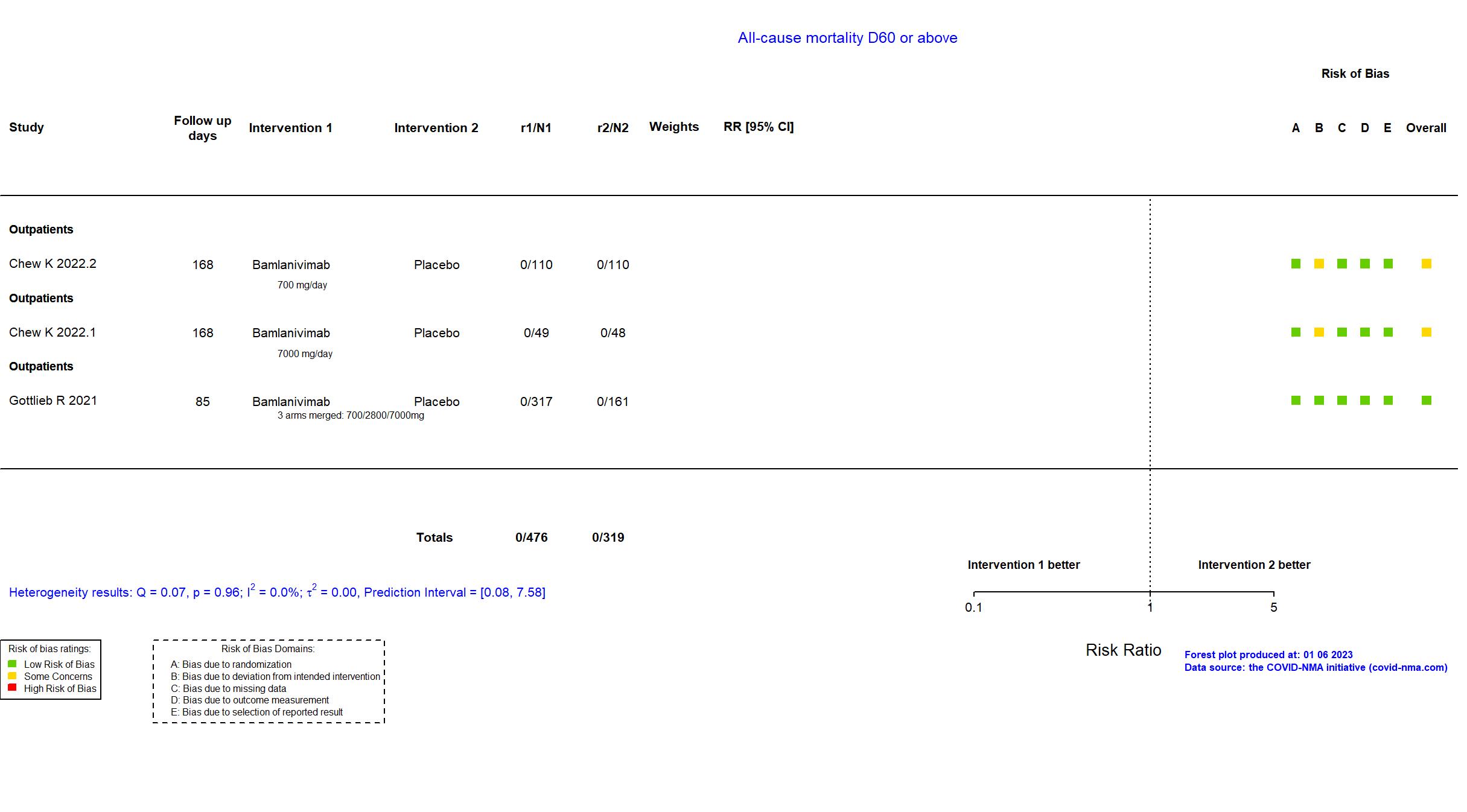
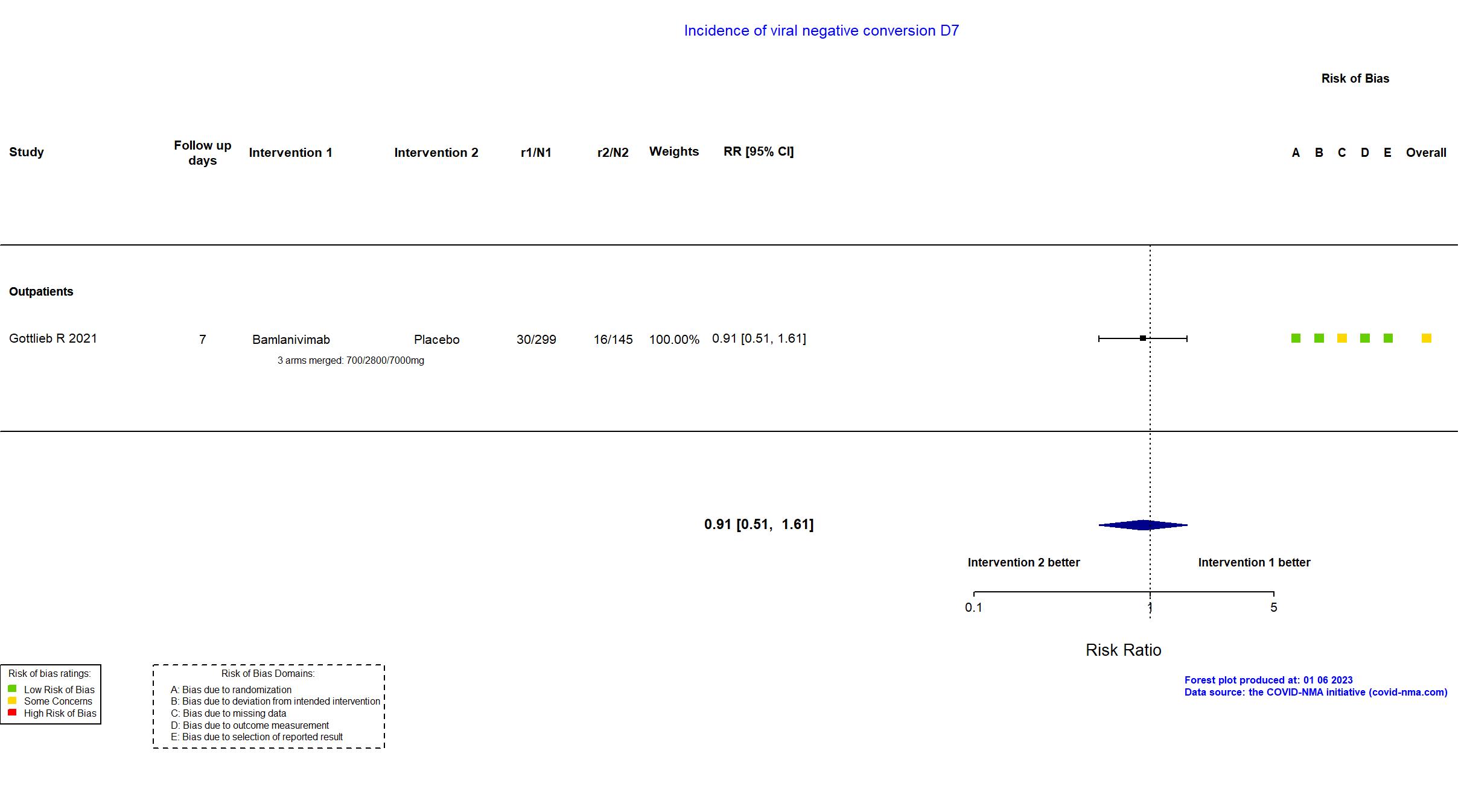
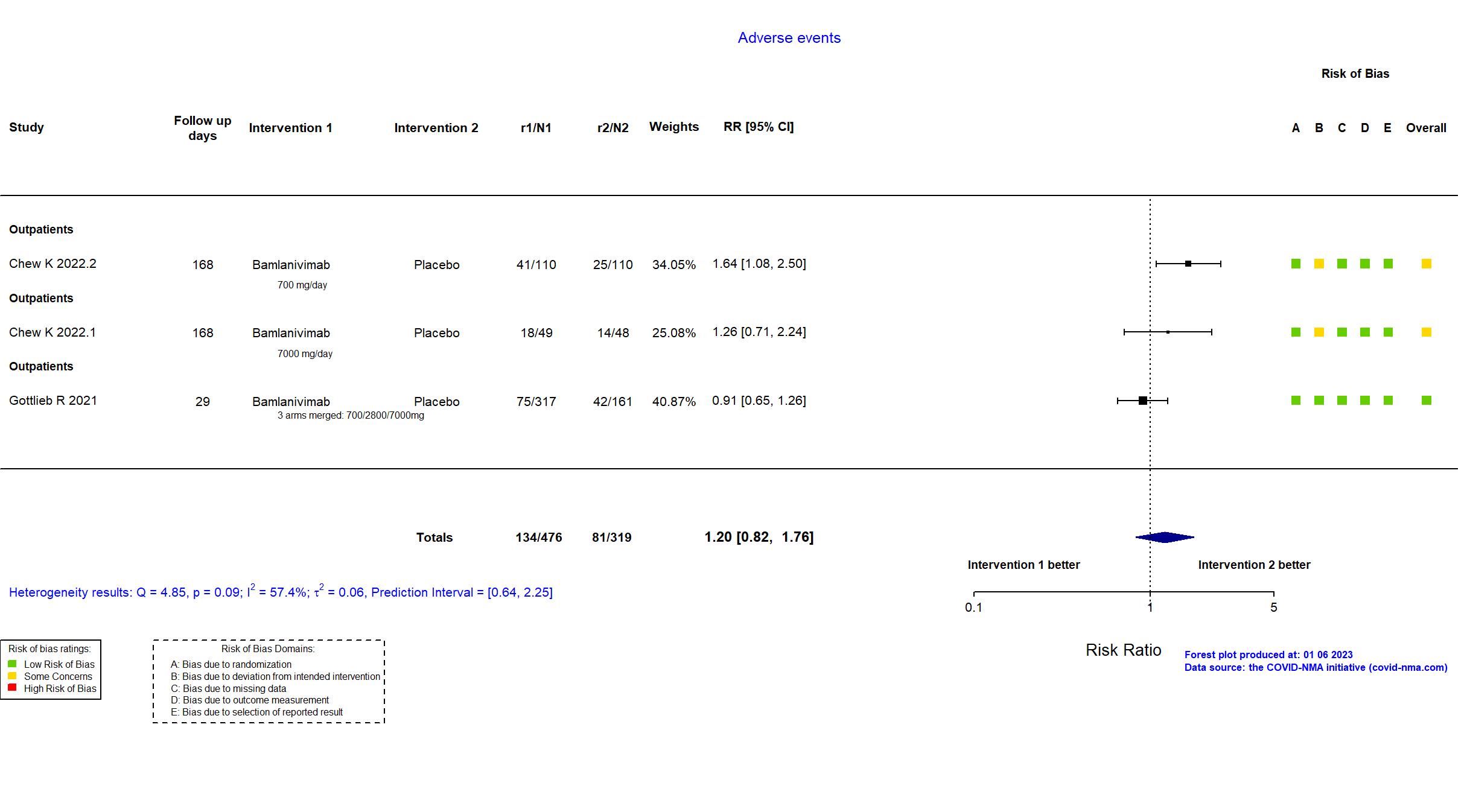
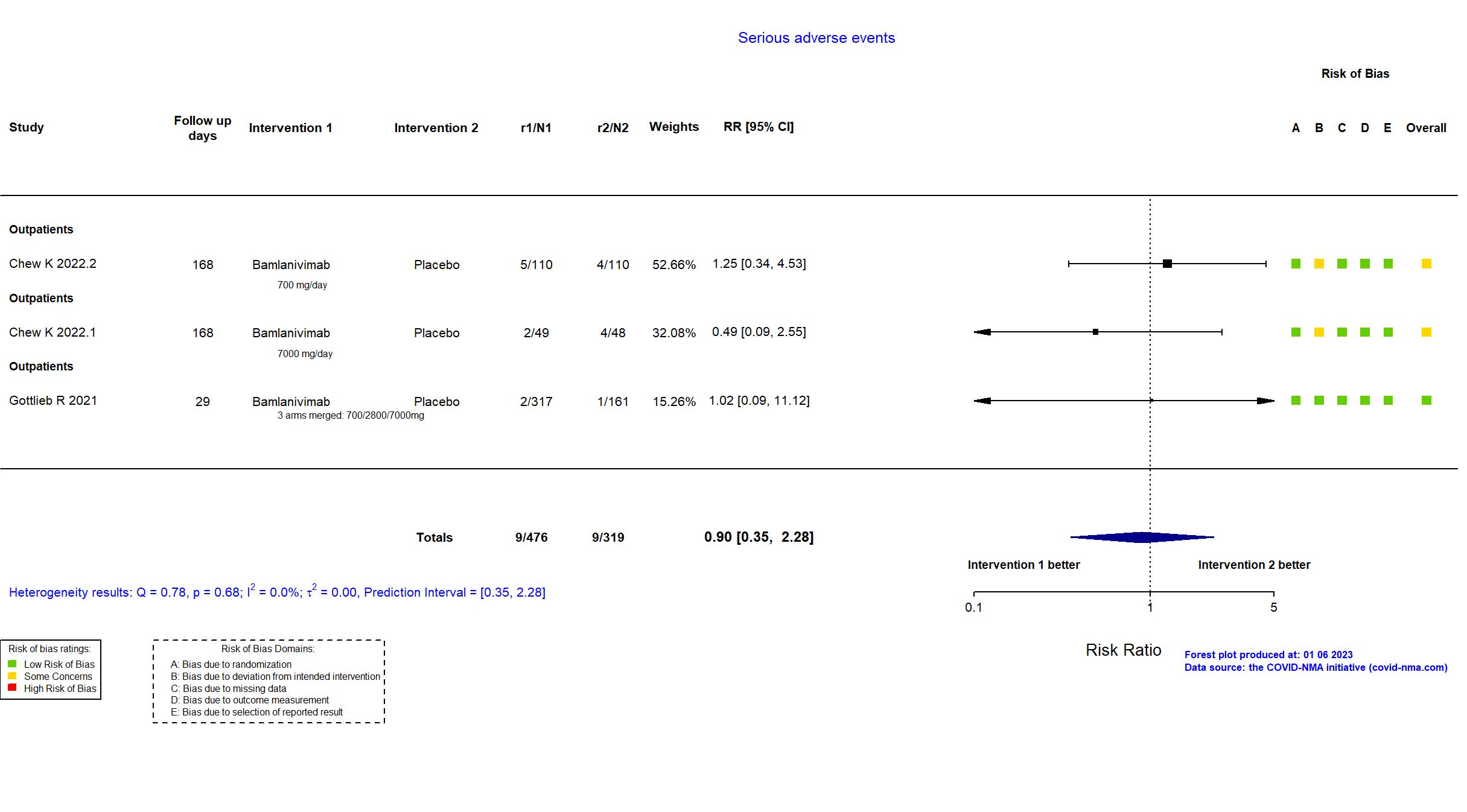
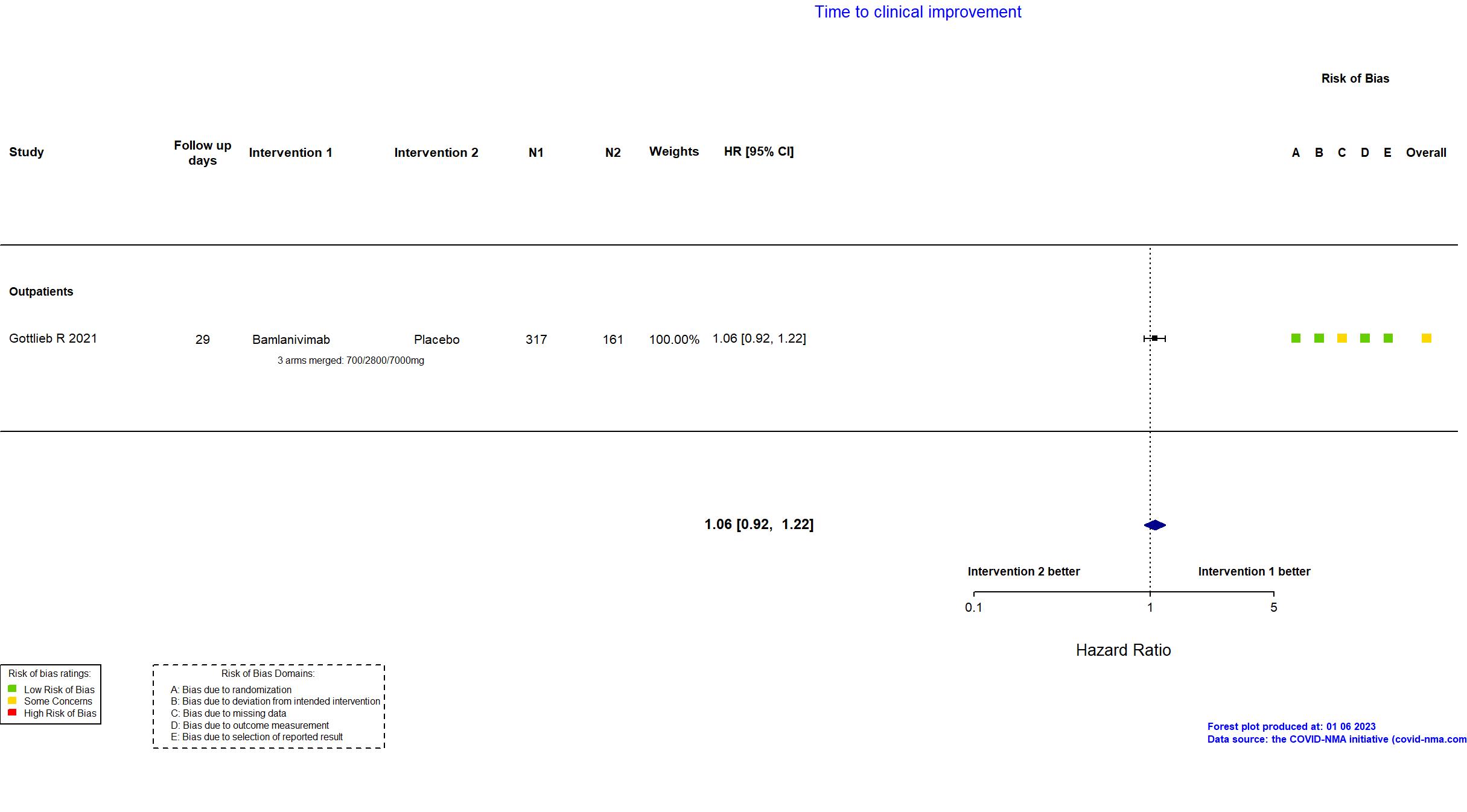
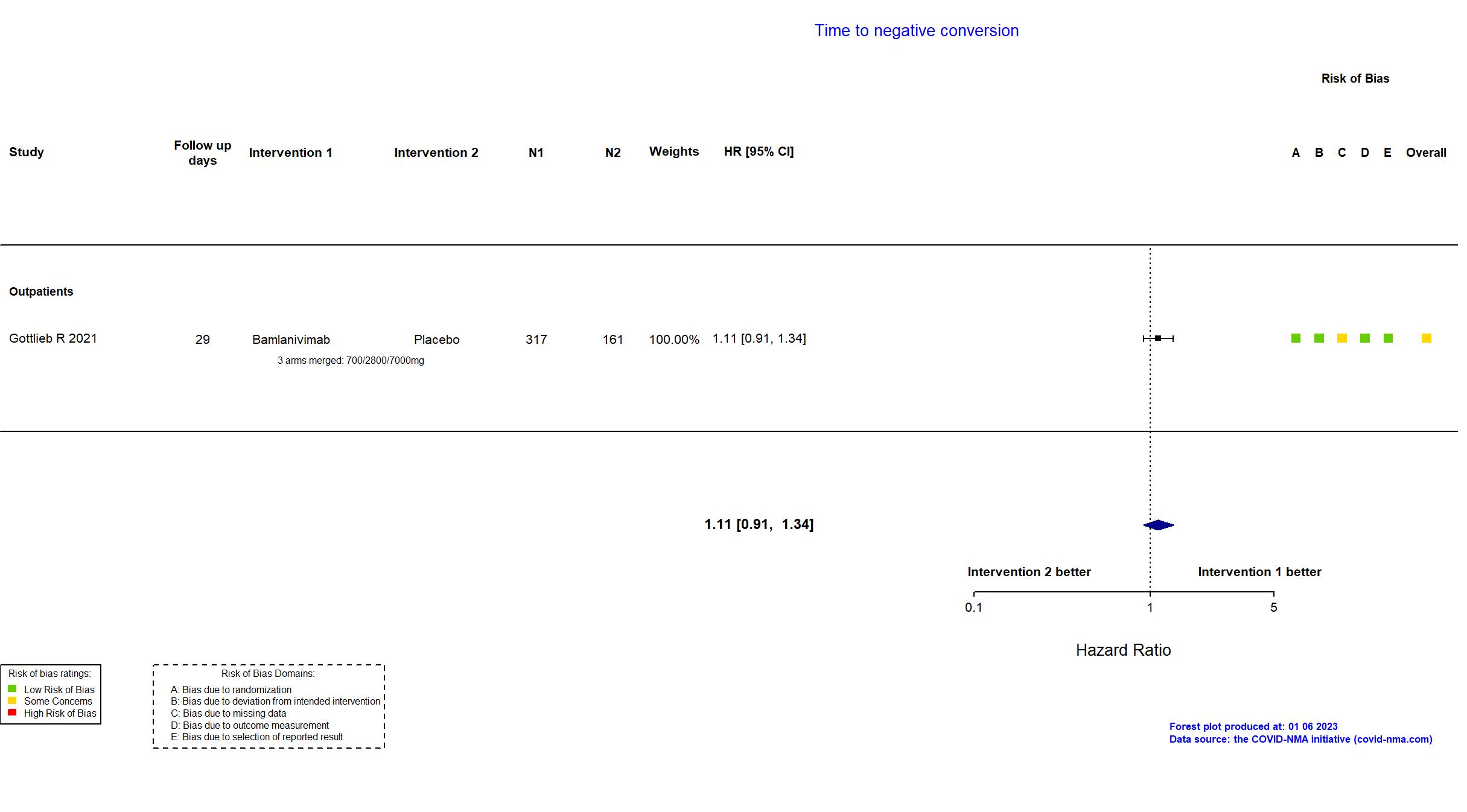









Trial NCT04427501
Publication BLAZE-1 - Chen P, N Engl J Med (2020) (published paper)
Dates: 2020-06-17 to 2020-08-21
Funding: Private (Eli Lilly)
Conflict of interest: Yes
| Methods | |
| RCT Blinding: | |
| Location :
Multicenter / USA Follow-up duration (days): 29 | |
| Inclusion criteria |
|
| Exclusion criteria |
|
| Interventions | |
| Treatment
Bamlanivimab 700/2800/7000mg arms merged, IV, once off for 1 hour. |
|
| Control
Placebo | |
| Participants | |
| Randomized participants : Bamlanivimab=317 Placebo=150 | |
| Characteristics of participants N= 467 Mean age : NR 203 males Severity : Mild: n= 452/ Asymptomatic: n=0 | |
| Primary outcome | |
| In the register Change from Baseline to Day 11 in SARS-CoV-2 Viral Load | |
| In the report Change from baseline in the SARS-CoV-2 viral load at day 11 (±4 days) after positive results on testing. | |
| Documents avalaible |
Protocol Yes. In English Statistical plan Yes Data-sharing willing stated in the publication:
|
| Risk of bias Overall The overall risk of bias reported in the table corresponds to the highest risk of bias for the outcomes assessed for the systematic review |
Low |
| General comment |
In addition to the published article, the trial registry, protocol, statistical plan, supplementary materials and response from contact with authors were used in data extraction and assessment of risk of bias. The published report was a preplanned interim analysis of patients randomized to receive one of three doses of LY-CoV555 (also known as LY3819253) and placebo. The pre-stated sample sizes for these arms were reached. Additional arms in which patients are randomized to receive and combination of LY3819253 and LY3832479 are ongoing. There were some differences in the outcomes included in the trial registry and protocol and the published article. There were no differences in study treatments.
This study was updated on December 29th with data received from contact with authors. The study was updated by Gotleib 2021 for all outcomes except hospitalization or death. We consider Gotleib as the updated report except for the outcome hospitalization or death that will be collected from this study. |
Trial NCT04518410
Publication ACTIV-2/A5401 - Chew K, Nat Commun (2022) (published paper)
Dates: 2020-08-19 to 2020-11-15
Funding: Mixed (National Institute of Allergy and Infectious Diseases of the National Institutes of Health, US Dept. of Energy, NIH, Los Alamos National Laboratory, Eli Lilly.)
Conflict of interest: Yes
| Methods | |
| RCT Blinding: triple blinding | |
| Location :
Multicenter / USA Follow-up duration (days): 168 | |
| Inclusion criteria |
|
| Exclusion criteria |
|
| Interventions | |
| Treatment
Bamlanivimab 7000 mg intravenously over 60 minutes |
|
| Control
Placebo | |
| Participants | |
| Randomized participants : Placebo=48 Bamlanivimab =49 | |
| Characteristics of participants N= 97 Mean age : NR 45 males Severity : Mild: n= 98/ Asymptomatic: n=0 | |
| Primary outcome | |
| In the register 1) COVID-19 symptom duration (Phase 2) [ Time Frame: Up to Day 28 ]; 2) Quantification of SARS-CoV-2 RNA (Phase 2) [ Time Frame: Day 3, 7, 14 ]; 3) Proportion of participants with new adverse event (AE) ≥ Grade 3 (Phase 2) [ Time Frame: Thru Day 28 ]; | |
| In the report 1) development of a Grade 3 or higher treatment emergent adverse event (TEAE) through 28 days; 2) detection (detectable versus undetectable)of SARS-CoV-2 RNA from NP swabs at days 3, 7, 14, 21, and 28; 3) duration of targeted COVID-19-associated symptoms from day 0. | |
| Documents avalaible |
Protocol Yes. In English Statistical plan Yes Data-sharing willing stated in the publication: Yes |
| Risk of bias Overall The overall risk of bias reported in the table corresponds to the highest risk of bias for the outcomes assessed for the systematic review |
Some concerns |
| General comment |
In addition to the pre-print article, the trial registry and the overall adaptive platform trial protocol and statistical analysis plan were used in data extraction and assessment of risk of bias. Supplementary materials referred to in the pre-print article were not available at time of extraction. There were minor differences between some primary outcomes in the article and the registry (an additional 28 day timepoint for RT-PCR in the article; additional 21 and 28 day timepoint for of detection (detectable versus undetectable) of SARS-CoV-2 RNA from NP swabs in the article; adverse events were only a phase 3 outcome in the registry); additional primary outcomes in the article were secondary outcomes in the registry. One participant analyzed in the intervention group was originally randomized to the 700mg versus placebo cohort in this platform study, but received 7000mg in error and was analyzed in the 7000mg bamlanivimab cohort. Recruitment to the trial (n = 97) of a 7000mg dose was terminated following outside evidence of no dose-response, and the protocol was adapted to assess a 700mg dose instead.
This study was updated on November 18th, 2022 with data extracted from the peer-reviewed report. |
Trial NCT04518410
Publication ACTIV-2/A5401 - Chew K, Nat Commun (2022) (published paper)
Dates: 2020-10-12 to 2020-11-17
Funding: Mixed (National Institute of Allergy and Infectious Diseases of the National Institutes of Health. Study medication was donated by Eli Lilly and Company.)
Conflict of interest: Yes
| Methods | |
| RCT Blinding: triple blinding | |
| Location :
Multicenter / USA Follow-up duration (days): 168 | |
| Inclusion criteria |
|
| Exclusion criteria |
|
| Interventions | |
| Treatment
Bamlanivimab 700 mg intravenously over 60 minutes |
|
| Control
Placebo | |
| Participants | |
| Randomized participants : Placebo=110 Bamlanivimab=110 | |
| Characteristics of participants N= 220 Mean age : NR 110 males Severity : Mild: n= 225/ Asymptomatic: n=0 | |
| Primary outcome | |
| In the register 1) COVID-19 symptom duration (Phase 2) [ Time Frame: Up to Day 28 ]; 2) Quantification of SARS-CoV-2 RNA (Phase 2) [ Time Frame: Day 3, 7, 14 ]; 3) Proportion of participants with new adverse event (AE) ≥ Grade 3 (Phase 2) [ Time Frame: Thru Day 28 ]; | |
| In the report 1) development of a Grade 3 or higher treatment emergent adverse event (TEAE) through 28 days; 2) detection (detectable versus undetectable)of SARS-CoV-2 RNA from NP swabs at days 3, 7, 14, 21, and 28; 3) duration of targeted COVID-19-associated symptoms from day 0. | |
| Documents avalaible |
Protocol Yes. In English Statistical plan Yes Data-sharing willing stated in the publication: Yes |
| Risk of bias Overall The overall risk of bias reported in the table corresponds to the highest risk of bias for the outcomes assessed for the systematic review |
Some concerns |
| General comment |
In addition to the pre-print article, the trial registry and the overall adaptive platform trial protocol and statistical analysis plan were used in data extraction and assessment of risk of bias. Supplementary materials referred to in the pre-print article were not available at time of extraction. There were minor differences between some primary outcomes in the article and the registry (an additional 28 day timepoint for RT-PCR in the article; additional 21 and 28 day timepoint for of detection (detectable versus undetectable) of SARS-CoV-2 RNA from NP swabs in the article; adverse events were only a phase 3 outcome in the registry); additional primary outcomes in the article were secondary outcomes in the registry. Two participants analyzed in the intervention group were originally randomized to the 7000mg versus placebo cohort in this platform study, but received 700mg in error and were analyzed in the 700mg bamlanivimab cohort. Two participants analyzed in the placebo group were also originally in the 7000mg versus placebo cohort study, but were analyzed against the 700mg group. The study (n=222) achieved the target sample size (n=220) specified in the protocol.
This study was updated on November 18th, 2022 with data extracted from the peer-reviewed report. |
Trial NCT04427501
Publication BLAZE-1 - Gottlieb R, JAMA (2021) (published paper)
Dates: 2020-06-17 to 2020-09-03
Funding: Private (Eli Lilly and Company)
Conflict of interest: Yes
| Methods | |
| RCT Blinding: Participants, outcome assessor and health care pro | |
| Location :
Multicenter / USA Follow-up duration (days): 29 | |
| Inclusion criteria |
|
| Exclusion criteria |
|
| Interventions | |
| Treatment
Bamlanivimab 700 mg IV single dose for 1 hour Bamlanivimab 700 mg 700 mg IV single dose for 1 hour Bamlanivimab 2800 mg 2800 mg IV single dose for 1 hour Bamlanivimab 7000 mg 7000 mg IV single dose for 1 hour Bamlanivimab+Etesevimab LY-CoV555: 2800 mg IV single dose for 1 hour LY-CoV016: 2800 mg IV single dose for 1 hour |
|
| Control
Placebo | |
| Participants | |
| Randomized participants : Bamlanivimab=317 Bamlanivimab 700 mg=104 Bamlanivimab 2800 mg=109 Bamlanivimab 7000 mg=104 Bamlanivimab+Etesevimab =114 Placebo=161 | |
| Characteristics of participants N= 909 Mean age : NR 300 males Severity : Mild: n= 678/ Asymptomatic: n=0 | |
| Primary outcome | |
| In the register Percentage of Participants Who Experience COVID-Related Hospitalization or Death from Any Cause [ Time Frame: Baseline through Day 29 ]; Change from Baseline to Day 11 in Severe Acute Respiratory Syndrome Coronavirus 2 (SARS-CoV-2) Viral Load [ Time Frame: Baseline, Day 11 ]; Percentage of Participants with SARS-CoV-2 Viral Load Greater than a Prespecified Threshold [ Time Frame: Day 7 ] | |
| In the report Change in SARS- CoV-2 log viral load from baseline to day 11 (+/-4 days). | |
| Documents avalaible |
Protocol Yes. In English Statistical plan Yes Data-sharing willing stated in the publication: No |
| Risk of bias Overall The overall risk of bias reported in the table corresponds to the highest risk of bias for the outcomes assessed for the systematic review |
Some concerns |
| General comment |
In addition to the published article, the trial registry, study protocol, statistical analysis plan, and supplementary materials were used in data extraction and assessment of risk of bias. Two outcomes described as primary in the trial registry are described as secondary in the protocol and reported as secondary outcomes. Otherwise there were no substantive differences between the published article and the trial registry, study protocol ad statistical analysis plan. The database lock occurred when the last patient randomized to treatment of bamlanivimab and etesevimab reached day 29. As a result, the target sample size specified in the registry was not achieved.
This is a phase 2/3 trial of previously published trial, Chen P, N Engl J Med, 2020 included in this review. Quote: "Interim results from the Blocking Viral Attachment and Cell Entry with SARS-CoV-2 Neutralizing Antibodies (BLAZE-1) trial with data for the 3 monotherapy doses of the neutralizing antibody bamlanivimab have been published. The current report presents the final data set for patients randomized to the 4 treatment groups and the placebo group in the initial portion of the trial, including findings for the bamlanivimab and etesevimab combination group, the 3 bamlanivimab monotherapy groups, and the placebo group." This study was updated on November 3rd, 2022 with the results published in the trial registry. |